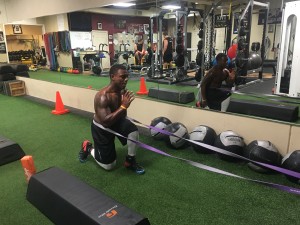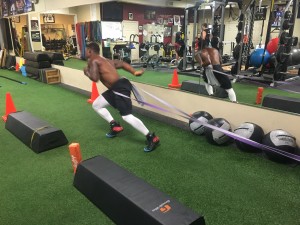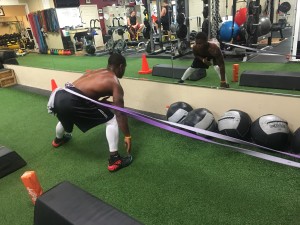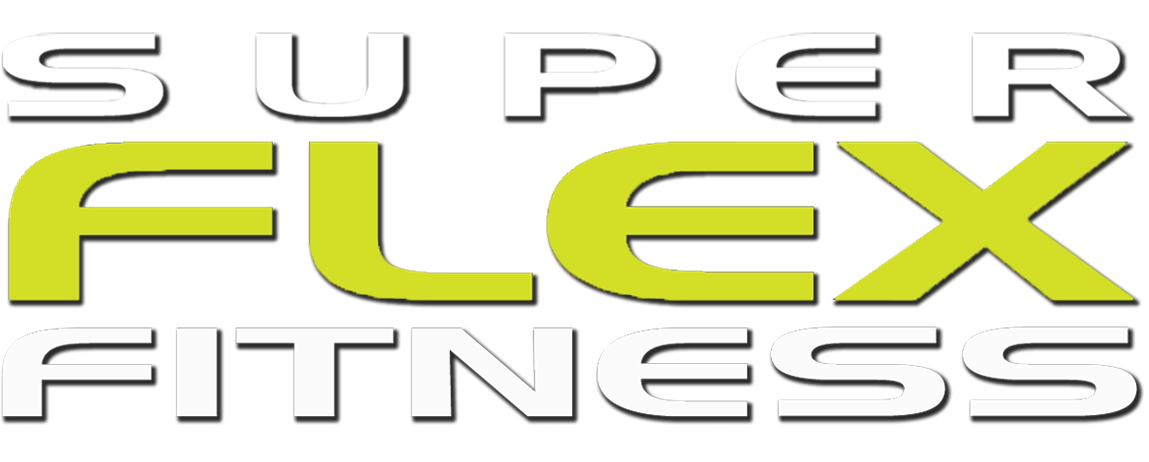Metabolic Mobility Matrix with SuperFlex Movement Bands
Integrated Athletic Mobility Prep
M3
Metabolic Mobility Matrix
Lunge/ Locomotion
As a competitive athlete, there’s a definitive difference in being in “good condition” and being physically prepared in the way that carries over to the field of play. No doubt, you can get in very good cardiovascular condition with a regular program of running, cycling, and any other version of endurance exercise. However, as an athlete– unless your sport is specifically the given activity– you’re wise to better address the physical demands of your sport. In our latest blog Mobility Matrix with SuperFlex Bands I will share with you our what I call our M3 – Metabolic Mobility Matrix.
NFL athletes working the M3 Metabolic Mobility Matrix. Check out Coach Vince’s video’s below and his drills with explanation of M3 and why the workout are so effective.
Your “Good Effort” Deserves Performance
Let’s take football as an example—Regardless of the position played, you’re best to prepare your body to move in multiple planes, to accelerate, decelerate, change direction, and to do it with both proficiency and efficiency. You need to be able to sustain a high level of performance move upon move, play after play, from opening kickoff through the 4th quarter, and possibly beyond. In other words, your performance will be a combination of mechanical integrity, effort, and how you manage fatigue.
It’s not enough to just rely on football practice, traditional weight room exercises, and high volume sprinting to address the attributes needed to perform at high levels –and to sustain optimal on-field performance. Your degree of effort may be admirable, but reality is it’s all relative to your actual on-field performance. You need to not only train the primary muscles involved in football but also their function. This does not mean to try and duplicate exact on-field skills but to train the primary muscles involved as well as the movement patterns that are most common on the field.

Bridging The Gap
There’s no doubt that football players need a base level of strength in the foundational muscles as well as the ability to rapidly produce force with that strength (read: power).
An effective general strength program for most any sport will include strength-based exercises for: upper body push (i.e. Bench Press), lower body hip dominant (i.e. Deadlift variation), upper body pull (i.e. Pull-Up, Row), lower body quadriceps-dominant (i.e. Squat variation), and then there are a few “core” drills that I’d consider foundational for most athletes regardless of their sport.
However, over the years I’ve witnessed more than a few “weight room warriors” with the best numbers on their school’s wall chart not demonstrate near that excellence between the white lines. The accomplishments in the weight room got dropped somewhere on the walk to the field.
Once the job gets done with general strength drills, athletic preparation becomes more specific, regarding the identified demands of the sport for the athlete. You need an aspect of training that act as an invaluable “bridge” between the gaps of basic strength training and the practice and game field.
In football, acceleration, deceleration, change of direction, jumping, and landing are all innate demands for the athlete. And, these actions will occur in a relatively small region of the field the majority of the time, though there are obvious occasions that area expands greatly.
The aspect of performance enhancement that is most “trainable” from an impact-on-performance perspective is an area that is approximately 3 yards by 3 yards. Yes, a football field is 100 yards long plus end zones, and 53 yards wide, yet individual plays are not only “won in the trenches” when referring to line play but on that “1st push, 1st step, 1st stop, 2nd push, …” with the skill position players. What happens 10-20, …or 99 yards downfield can be traced back to the first few moves in the aforementioned “3-yard box”.
Enter SuperFlex Movement Bands
Over 3 decades of training athletes, I’ve found high-quality resistance bands—as SuperFlex Bands are– to be of the most valuable tools available in training athletes to move better, and to do so in the way that has a high rate of mechanical retention. This consistency in performance comes from the value of resistance bands that seldom gets mentioned. When you place a resistance band around the hips or midsection of an athlete, they become more aware of their true center of gravity, which is where optimized movement initiates.

Dynamic Assessments
From a coaching perspective the benefits of teaching movement skills with resistance bands can be obvious. The band provides not only resistance but also a way for athletes to immediately know themselves when they are compromising mechanical integrity by not producing adequate force into ground or by staying too high on deceleration. Passive assessments have their place, yet it’s dynamic assessments like these that are where the rubber genuinely meets the road. The SuperFlex Movement Band allows you to coach within a defined space where more “revealing reps” will be performed rather than in typical “speed/agility” drills where you get a single opportunity to ‘catch & cue’ a specific skill. Of course the presence of video can be valuable here but I maintain that even then, using resistance bands here is a very wise option.
Video: Coach Vince discussing his M3 – Metabolic Mobility Matrix with SuperFlex Movement bands program.
Maximizing and Minimizing
Generally speaking, optimized performance and injury prevention are complementary. When performance is compromised due to fatigue (or simple lack of attention or discipline), injury risk escalates. Learning to move correctly, and practicing these skills until they are engrained, will not only lead to maximizing performance at each stage of competition but help minimizing injury potential as well.
The SuperFlex Movement Band provides the prime tool to externally teach optimal dynamic biomechanics, to internally reinforce these mechanics for greatest retention, and to condition the athlete to sustain these mechanics with the least degree of compromise even in the environment of high stress and fatigue.
The sequence of drills I’m sharing in this installment of the SuperFlex IAMP series is one of our go-to complexes for improving a football player’s mechanics, mobility, balance, and conditioning that are all key principles influencing how that athlete will perform on the field.
Multi-Purpose By Design
Ironically, I initially designed this complex primarily for the purpose of metabolic conditioning. However, upon implementing the program over the course of several weeks, I found that many other athletic attributes were being positively impacted.
Any time we can get multiple benefits in a program, it’s a win-win in my view as long as the original objective is sustained. And, as you’ll experience with regular application of this complex as designed, the conditioning effect is most certainly sustained. Matter of fact, I’ve actually relied on this complex in combination with a few other metabolic circuits to get collegiate and professional athletes in indomitable condition, and while remaining exceptionally healthy, heading into team conditioning programs and/or their respective competitive seasons. Yes, that means no conventional sprints like “Gassers” or “110’s”.
The other considerable benefits include, but not limited to, dynamic lower body mobility, dynamic stability of the lower extremities, lower body strength endurance, injury prevention of hip, knee, and ankle, and the previously mentioned honing of speed/agility mechanics. Oh yeah, there’s also a pretty good mental toughness benefit to this complex once the fatigue starts to arrive.

The M3 Complex
The SuperFlex Movement Band series is the best of its kind on the market. The quality is first-class and the variety of strengths and lengths will serve any and all levels. These 80” Movement bands are 2x as long as the regular 40” SuperFlex bands, and there are also 110” versions. My experience is that the longer bands are best for more advanced athletes as they allow the locomotion variation to go out slightly further from the anchor point. That said, the 80” Movement bands would certainly be sufficient.
The Metabolic Mobility Matrix (M3) is comprised of 5 “pairings” of a lunge variation and a lower body locomotion drill. A locomotion drill that complements the lunge pattern will follow the specific lunge.
You can perform this complex in reps or in a timed circuit fashion. I prefer the timed version especially when dealing with groups of athletes. Most athletes understand the value of using a specific allotted time to their fullest benefit so it’s the better of the two options in my experience. That said, if you choose the “counting reps” option, begin at sets of ’10 reps’ each drill. And minimize the transition time between drills.
With the timed version, I’ve found the 25 seconds work, 5 seconds rest/transition to work very well. It will help to extend the transition time in the learning stages of the program. One effective recommendation is to work with a 25:25 ratio then make gradual decreases in transition time (rest) as the athlete(s) progress. Perform 1 complex 2-3 times a week for the first week or two after strength training.
After Week 1, go up to 2 complexes with 90 seconds rest between complexes. Beginning Week 3, increase to 3 complexes and 2x a week. After 2 more weeks, assess progress then either sustain that volume or increase to 4 complexes. All with 90-120 seconds rest between complexes.
Video: Coach Vince demonstrating exercise sequence of drills in his M3 – Metabolic Mobility Matrix with SuperFlex Movement bands works.
M3 Drills and Exercise Sequence:
Anchor the Movement band on a sturdy support, or have a reliable partner hold the band (without moving). Set up a defined area that is 3 yards long.
1. Reverse Lunge (right foot forward) with contralateral knee drive
2. Linear Sprint repeats with ground touch (right foot forward)
3. Reverse Lunge (left foot forward) with contralateral knee drive
4. Linear Sprint repeats with ground touch (left foot forward)
5. Alternate Forward Lunge with low reach *facing and stepping towards anchor point
6. Backpedal repeats *facing towards anchor point
7. Lateral Lunge with low reach (to right) *stepping towards anchor point
8. Change-of-direction Sprint to Lateral Shuffle decelerate return *Running away from anchor point
9. Lateral Lunge with low reach (to left) *stepping towards anchor point
10. Change-of-direction Sprint to Lateral Shuffle decelerate return *Running away from anchor point
Focus on the quality of each rep, as quality is the only characteristic you fully control, and can build potential on. Do not rush the reps with either the lunge or locomotion drill. On locomotion drills, keep feet moving. At no point in locomotion drills do feet stop moving.
Give the SuperFlex M3 program an honest commitment for 4-6 weeks and experience how your, or your athletes’, realworld conditioning takes flight.
–Vince McConnell McConnell Athletics
